Untangling the ‘Barbenheimer’ Box Office Paradox
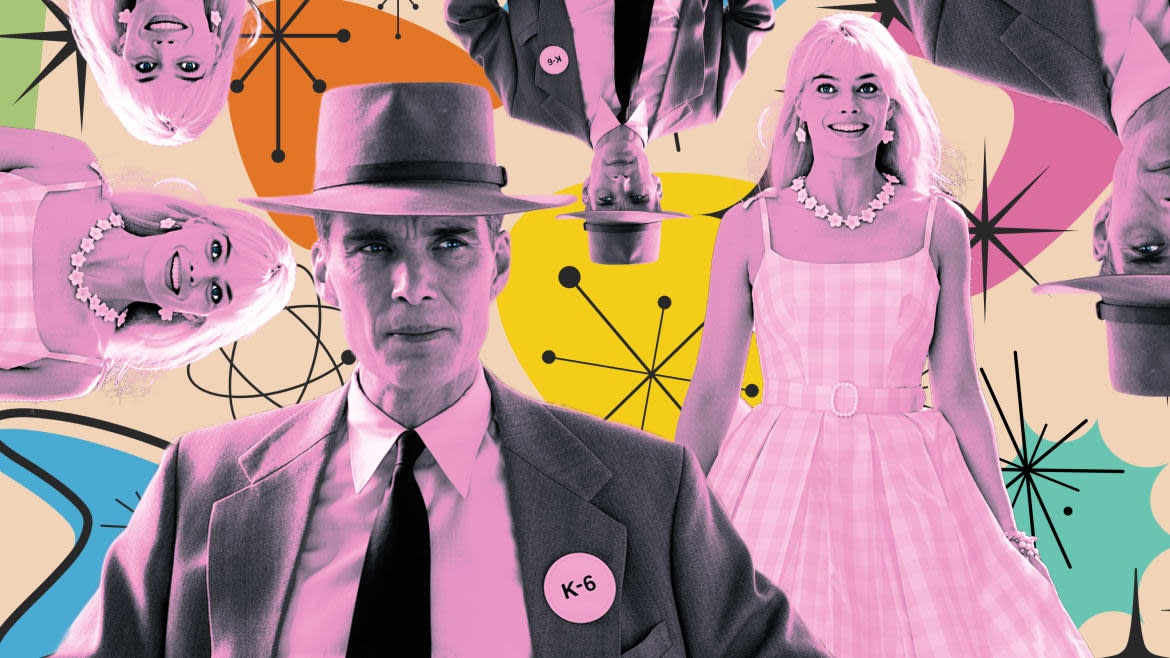
- Oops!Something went wrong.Please try again later.
- Oops!Something went wrong.Please try again later.
- Oops!Something went wrong.Please try again later.
Like a rose-colored mushroom cloud, Barbie and Oppenheimer have towered over the box office since their debut. Movie theaters, whose crowds have atrophied since COVID-19 wrested filmgoers out of cinemas and onto their couches, are suddenly packed. Guests are showing up in custom T-shirts, decked out in pink, or, best of all, in costumes that switch from black to pink, in honor of summer’s FOMO-fueled double feature.
There’s a distinct sense of nostalgia to Barbenheimer mania—the same feeling you might’ve had when you turned up at your local cinema as a teenager for a midnight premiere with all of your friends. At a time this bleak, when all of us feel so isolated, it’s a relief to feel like part of something—especially something this fun.
Already, however, there’s a concern that studios might read this phenomenon as a sign that the public really craves, say, a Mattel Cinematic Universe. Lena Dunham’s freshly announced Polly Pocket movie with Emily in Paris star Lily Collins has elicited a collective groan, as Barbenheimer-heads worry that studios will walk away from this sensation having learned the “wrong lessons.”
You Don’t Have to See ‘Oppenheimer’ the Fancy Way
To some, Barbie and Oppenheimer’s record-shattering debuts represent a spark of originality that the industry seems bound to forsake. People are thrilled, the narrative goes, to watch a movie that’s not a reboot or a sequel. As Vanity Fair chief critic Richard Lawson points out, “It was beginning to seem that no non-franchise movie would ever be a blockbuster again.”
As much as I enjoyed watching both films, however, the argument that Barbie or Oppenheimer meaningfully buck current Hollywood trends feels a little dishonest. Are we really going to pretend that a movie about America’s most infamous doll and another about a prominent figure from World War II (a beloved subject for dads across the country) are somehow scrappy success stories?
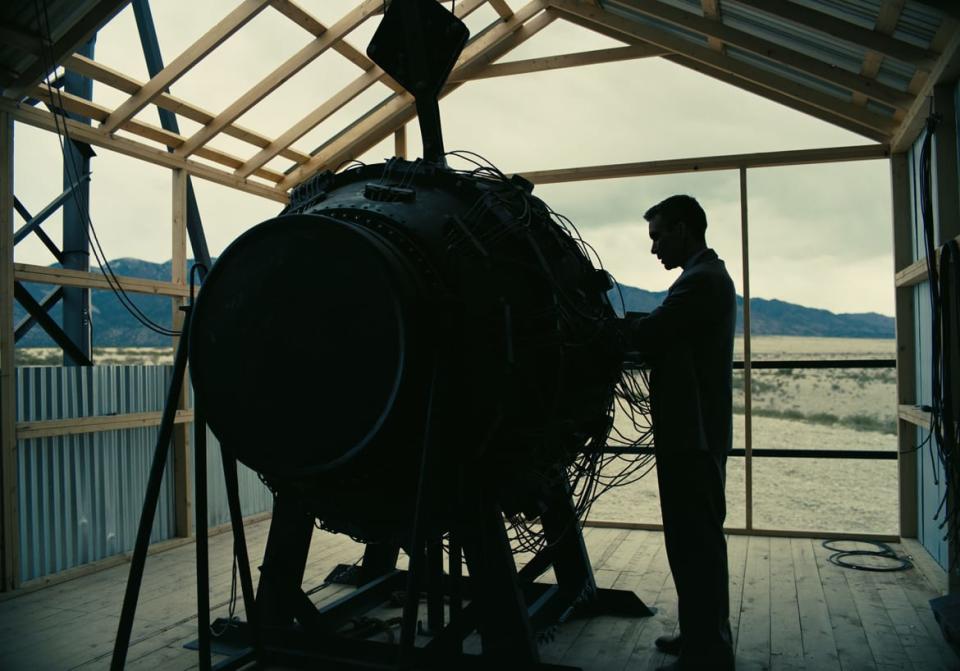
Cillian Murphy as J. Robert Oppenheimer.
As accomplished as these films are—and both do pull off some stunning artistic feats—neither one feels like a particularly revolutionary product for an industry that already loves making films based on toys and biopics about famous (often white) historical figures. Rather, they feel like the best-case results one can expect when the industry functions exactly as intended.
Gerwig’s Barbie movie works as far more than a commercial for the iconic doll. In a review of the film for Autostraddle, film critic Juan Barquin noted that even in spite of its dated feminist politics, Barbie does critique the false gender binaries that Mattel and so many other toy companies have peddled for so long. “In fact,” they write, “it’s not a stretch to say that Gerwig is, rather radically, blaming the very company she is working for for enforcing and damning us to a life of this very essentialism.”
It’s also hard to overstate how gorgeous Barbie’s production is. Its practical sets are stunning, and each and every performance (from stars including Margot Robbie, Ryan Gosling, Issa Rae, America Ferrera, Simu Liu, Hari Nef, Dua Lipa, Michael Cera, and seemingly half of Hollywood) seems to land flawlessly. The gags about Barbie’s tippy-toe feet and her plastic food are clever both in concept and execution. And perhaps most importantly, Barbie herself would kill for those costumes.
Mary Pipher, the Author Who Inspired ‘Barbie,’ Has Changed Her Mind About the Dolls
And yet, as I sat there on the bus on my way home from the cinema, my buzzkill brain began to nag at me. Was Will Ferrell’s evil CEO just an obvious (and, frankly, unnecessary) knock-off of his role in The Lego Movie? Why are we peddling Barbie creator Ruth Handler’s romantic narrative about creating the doll for her daughter, when Barbara Handler herself has said she’s embarrassed by her association with the doll? And if Barbie really is for everyone now, why do only one or two of the dolls in Barbieland break from her stereotypical hourglass figure? (All of the Kens are still ripped.)
Barbie might be more than a commercial for the dolls, and it might critique the company that made them, but it’s also incredibly effective brand management. Before Barbie even premiered, Mattel had 45 projects in development based on its toys, according to the New Yorker—including that Polly Pocket film that’s now got social media in a tizzy. Gerwig’s film has provided the perfect launchpad, just as intended.
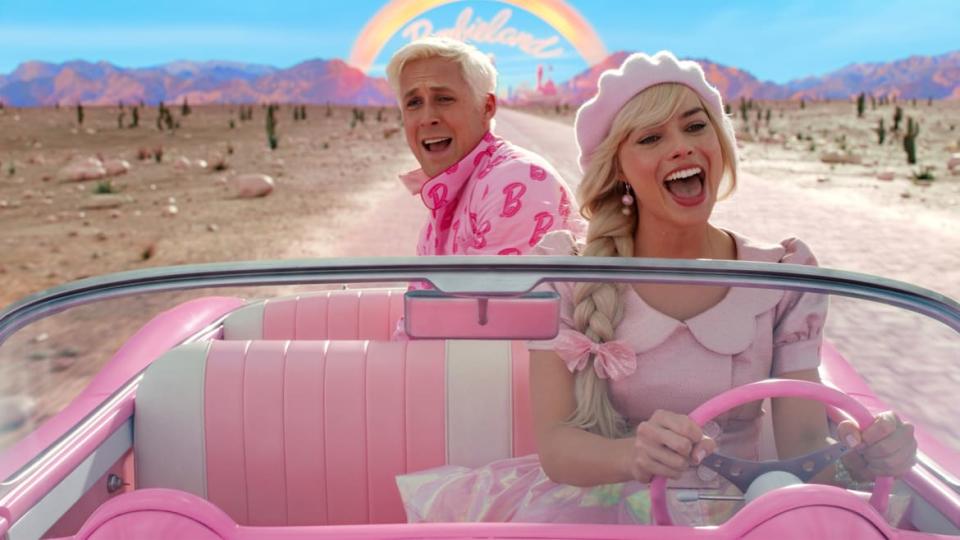
Ryan Gosling and Margot Robbie in Barbie.
Although Barbie dings Mattel, the details it picks and chooses also help the company self-mythologize. While narrator Helen Mirren tells us at the start of Barbie that little girls had only baby dolls before Barbie, that’s not quite the case. The gap Handler saw in the market apparently had more to do with how Barbie’s alternatives looked.
“Oh, sure, there were so-called fashion dolls,” Handler wrote in her 1994 autobiography, Dream Doll, according to Insider. But she didn’t like their bodies. In Handler’s estimation, the dolls’ “flat chests, big bellies, and squatty legs” made them look “like overweight six- or eight-year-olds.”
During a family trip to Europe, Handler spotted a German doll named Lilli, a popular bachelor party gift that had sprung out of a comic strip about a secretary described by some as a call girl. The toy’s accompanying slogan? “Gentlemen prefer Lilli.”
In spite of her origins, the Lilli doll had already become popular with children by the time Handler spotted one and decided to rip it off. As Handler wrote, “Here were the breasts, the small waist, the long, tapered legs I had enthusiastically described for the designers all those years ago.”
According to Vanity Fair, Louis Marx and Company, which held the “Lilli” license, sued Mattel over Barbie’s similarities in 1961. The parties settled in 1963, VF reports, and a year after that, Mattel bought the license from its original manufacturer, Greiner & Hausser.
It’s hardly surprising that none of this comes out of Rhea Perlman’s mouth as she plays Handler in Gerwig’s film. That critique—that Barbie’s image of empowerment was also bound up in having a specific kind of body, one that its creator essentially copied for her product—might be a little too honest for Mattel to stomach. Better to stuff a few generic barbs into a grumpy teen’s mouth so that her mother can correct her later with her own monologue, effectively resolving all our reservations and allowing us to join Barbie, Ken, and their pals on the beach.
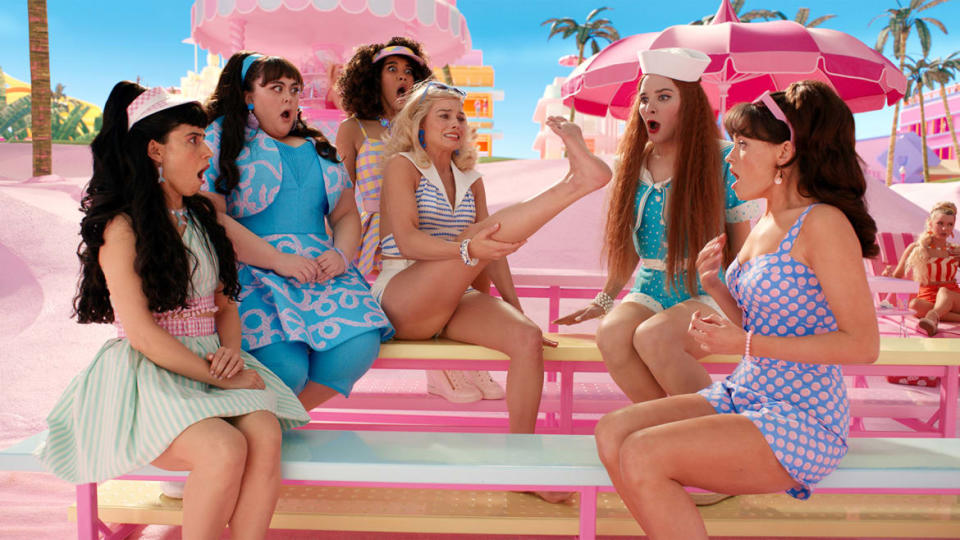
Ana Cruz Kayne, Sharon Rooney, Alexandra Shipp, Margot Robbie, Hari Nef, and Emma Mackey.
There’s no shortage of irony to conservatives’ pearl-clutching reaction to Barbie and its feminism, which the Piers Morgans and Ben Shapiros of the world have of course labeled as misandrist. As other critics have pointed out, Nolan’s Oppenheimer feels like a stronger indictment of men—or at least, men with any modicum of power. But that film, too, seems to reinforce old tropes we’ve seen before.
The ‘Oppenheimer’ Sex Scenes Are Cringey, But Not Because of the Sex
Much has been made of Nolan’s decision not to depict the devastation that Oppenheimer’s creation rained down on Japan. The director has argued that he limited the film to Oppenheimer’s perspective to emphasize how he would have experienced the bombings via radio. During a scene late into the film, Nolan chooses to show Oppeheimer looking away during a debriefing slideshow about the bombs’ destruction of Hiroshima and Nagasaki—just as the person narrating it says that “virtually everyone in the street for nearly a mile around was instantly burned.”
After the movie ended, I found myself googling that detail to no avail. Did Oppenheimer really turn his head, unable to bear looking at what his creation wrought? Or was this a convenient way for Nolan himself to avert his eyes and focus, instead, on his protagonist—a man that his film calls self-important while also, paradoxically, choosing him as its namesake? (Perhaps it’s time for this moviegoer to actually read the book upon which Oppenheimer was based and find out if the answer lies there.)
Ultimately, the veracity of that detail doesn’t matter; as other critics have noted, Nolan’s film buffs out a lot of details that might’ve complicated its story. Even putting aside the personal details the writer-director has redacted within Oppenheimer’s biography, which speak to a greater capacity for violence than we see on screen, the film also advances a glaring historical inaccuracy: Contrary to what Oppenheimer portrays, Los Alamos was not virtually uninhabited before the military built a company town there for the Manhattan Project. In fact, as a recent piece for Slate notes, many people were displaced—among them, Hispanic homesteaders who received as little as a paltry $7 per acre when they were forced to relocate. (White ranch owners apparently got $43 per acre.)
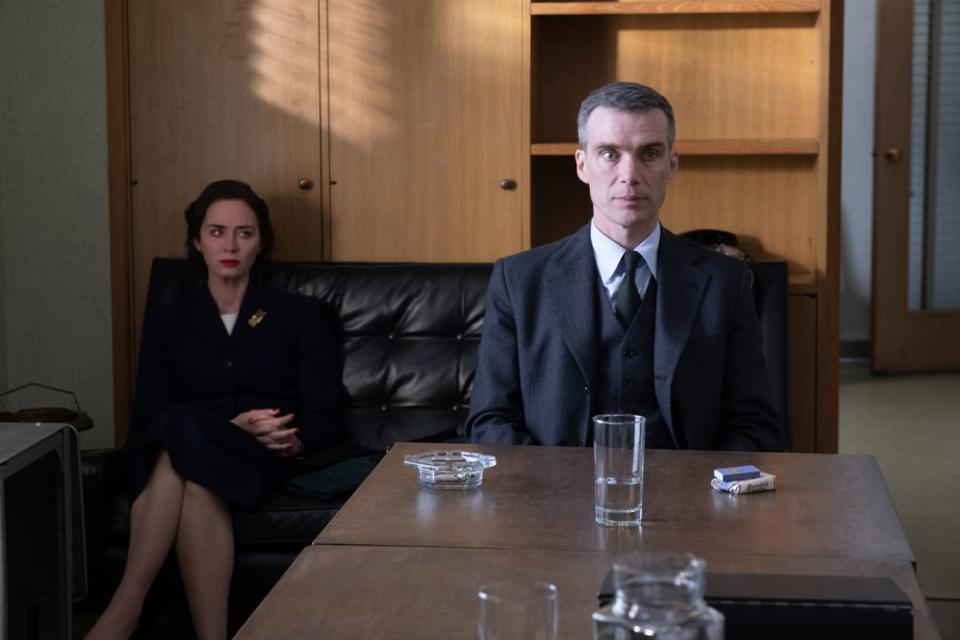
Emily Blunt and Cillian Murphy in Oppenheimer.
It’s true that plenty of Japanese art and cinema has unraveled the consequences of the atomic bomb, and in many ways, the artists behind those works are likely more qualified to speak on it than Nolan or any white creator. But the problem with Oppenheimer is more multifaceted than declining to show the bomb’s effects. The film turns its back not just on Japan, but also on countless victims of Oppenheimer’s work, and the nuances that would’ve demanded a more complicated story; in doing so, it upholds the exact kind of culturally enforced, imperialistic denial it attempts to critique.
‘Barefoot Gen’: The Horrifying, Must-Watch Atomic Bomb Film from the Japanese POV
Only in a creatively impoverished film landscape, where the mid-budget film has been decimated in favor of the latest Marvel installment, could the concept behind Oppenheimer strike anyone as refreshing or novel. Even after the Barbenheimer juggernaut, 2015’s American Sniper—another military-focused biopic—still holds the record of biggest opening in the U.S. for a biographical film.
Barbie and Oppenheimer might seem like a dichotomous duo, they do share some commonalities. Both films seem to weaponize self-awareness to pre-empt critique of their central figures—Barbie, through its overwrought monologues, and Oppenheimer, by emphasizing Oppy’s remorse in its ending, a long-teased conversation with Albert Einstein that Nolan treats like the key to some sort of emotional puzzle. Nolan and Gerwig, meanwhile, are two of our most sought-after directors right now, as the scale of each of these productions reflects.
There’s no shortage of big tentpoles these days, although more and more of them orbit around pre-existing IP. Really, what’s disappeared from Hollywood are mid-budget films—everything from smaller dramas, to romantic comedies, erotic thrillers, and other genre fare. Barbie and Oppenheimer’s success was never going to fix this problem, and it’s not up to Nolan or Gerwig or any other director to compromise their own success in response.
At the same time, heralding these films’ impressive reception as a positive sign for film overall feels like a misdiagnosis of the core problem. If nothing else, it’s telling that as Gerwig seeks to become a “big studio director” (as her agent Jeremy Barber described it to the New Yorker in that Mattel report), she had to direct a film like Barbie.
“Is it a great thing that our great creative actors and filmmakers live in a world where you can only take giant swings around consumer content and mass-produced products?” Barber asked. “I don’t know. But it is the business.”
Wondering aloud whether auteurs like Hal Ashby or Sydney Pollack might be making movies about toys if they were alive today, he added, “It’s also an argument that we’ve lost already.”
Get the Daily Beast's biggest scoops and scandals delivered right to your inbox. Sign up now.
Stay informed and gain unlimited access to the Daily Beast's unmatched reporting. Subscribe now.

